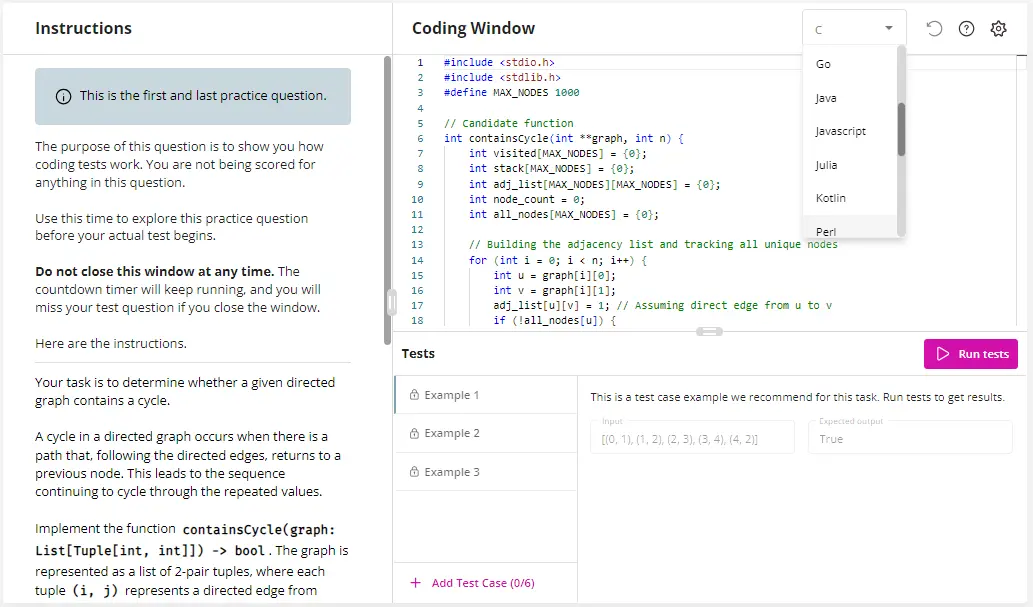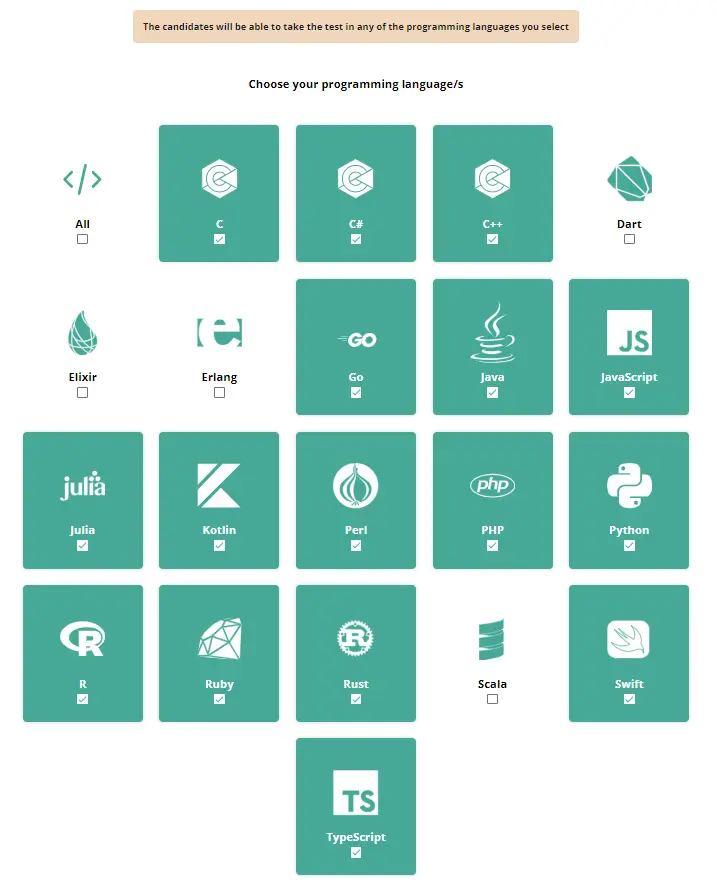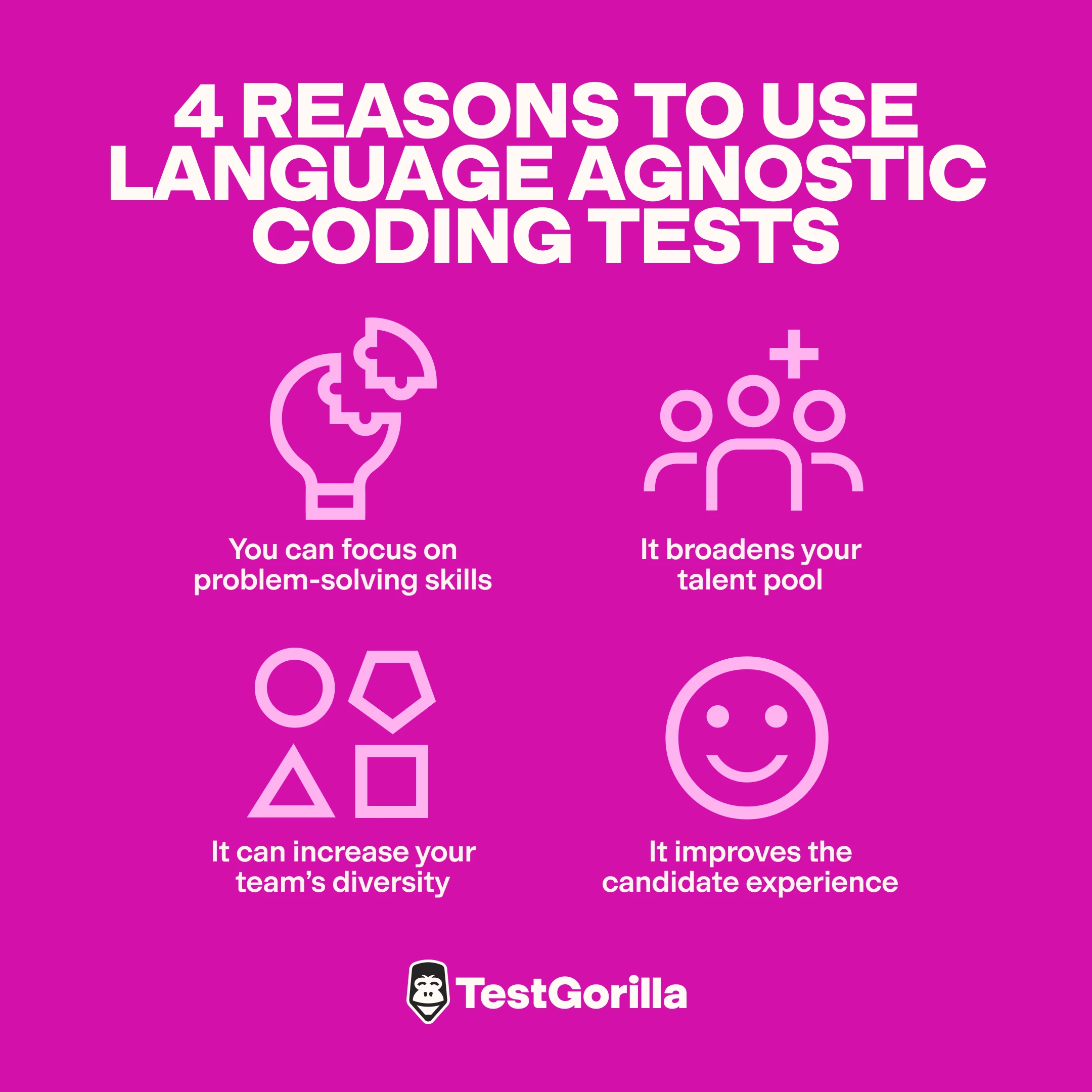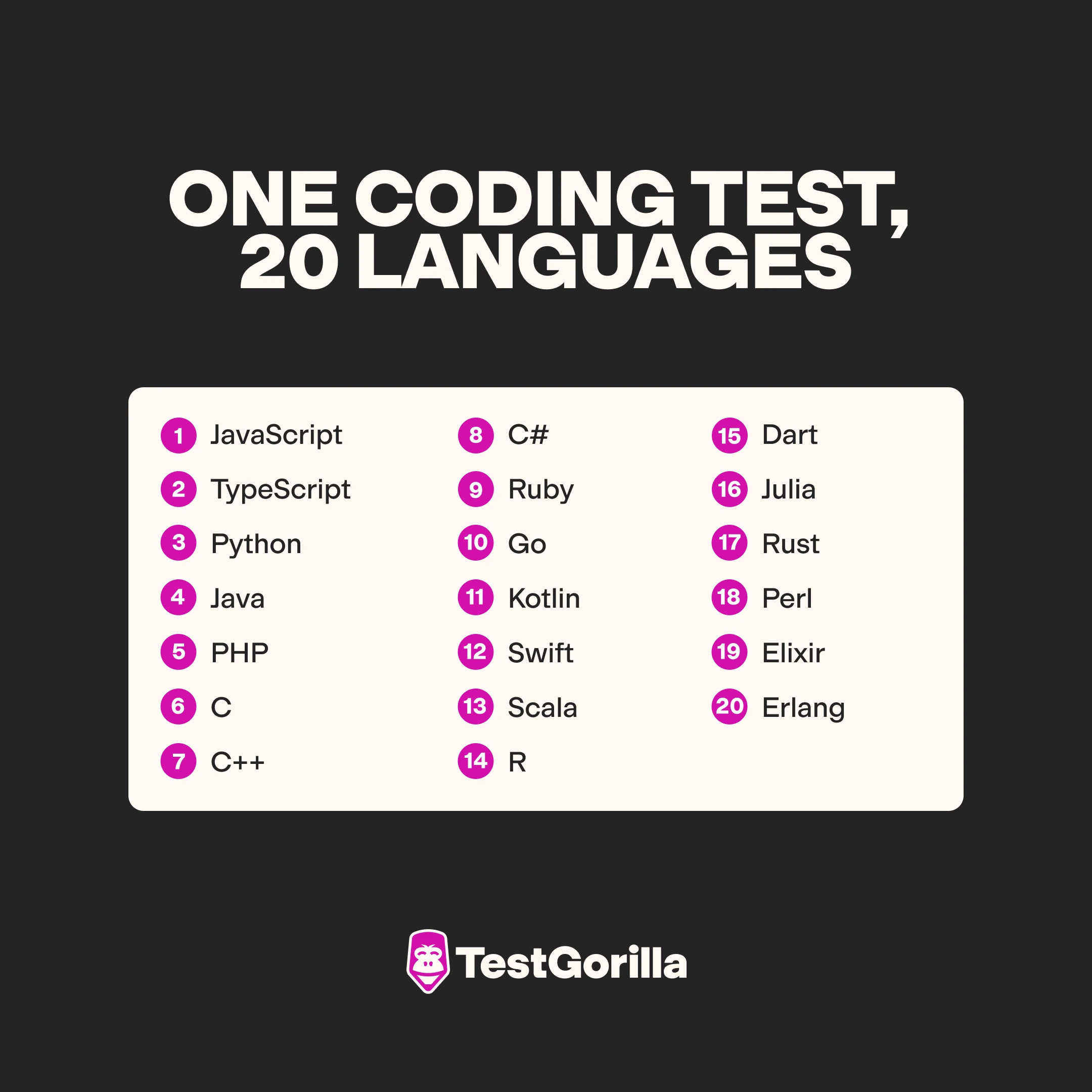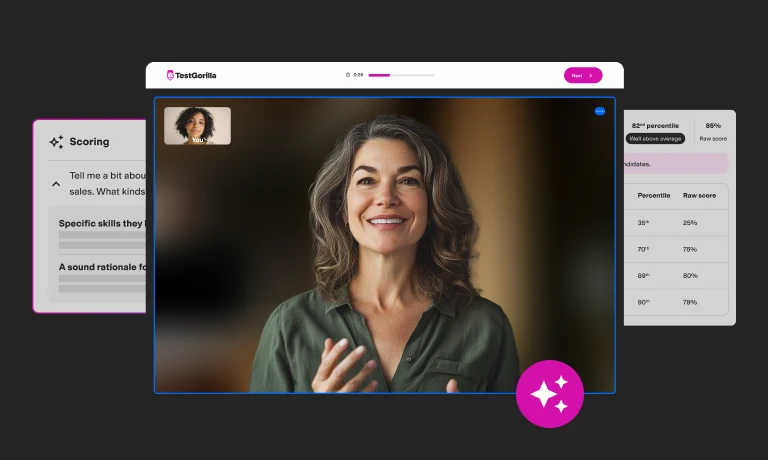4 reasons to use language agnostic coding tests in your hiring process
TestGorilla’s IP development and engineering teams have been working hard to update our platform’s coderunner. A major reason why we’re doing this is to make sure it can support language agnostic coding tests.
We’re big fans of language agnostic coding tests, and this work represents an important development – not just for TestGorilla, but for the world of coding tests more widely. Things are changing, and testing universal coding skills in a language-specific environment just doesn’t cut it anymore. In fact, this creates unnecessary barriers for engineering candidates and prevents employers from focussing on the skills that matter.
Want to know why? Whether you’re completely new to coding tests or you’re considering switching from using language-specific coding tests to language-agnostic ones, you’re in the right place. Read on as I explain what language agnostic coding tests are and why you should incorporate them in your hiring process.
What is a language agnostic coding test?
Skills-based coding tests are a cornerstone of the tech recruitment process, offering an insightful look into a candidate's practical abilities and problem-solving prowess. Traditionally, these assessments have been tied to specific programming languages, aligning with the role in question or the company's primary tech stack. These are known as language specific coding tests.
A language agnostic coding test sets the candidate a challenge that tests universal coding skills, and is equally challenging whichever programming language is used to solve it.
Once the candidate has assessed the problem, they can choose which of the available programming languages they would like to use from the drop-down menu at the top of the integrated development environment (IDE), then code their solution. It’s as simple as that!
View figures 1 and 2 to see what this looks like for both TestGorilla’s customers and their candidates.
Fig. 1: What candidates see. Notice the drop-down that allows you to select a coding language.
Fig. 2: What customers see. Customers can select which coding languages their candidates can take the test in.
4 reasons to use language agnostic coding tests in your hiring process
Assessing universal programming skills with language-agnostic coding tests can transform the effectiveness of your hiring process. Let's delve into why.
1. You can focus on problem-solving skills
What's more crucial: A candidate's ability to think critically and adapt, or their expertise in a particular programming language?
Universal programming principles such as logic, flow control, and data structures are foundational and can be demonstrated in any programming environment. The theory of transfer of learning proposes that skills learned in one context can be effectively applied to similar, yet new situations – so this is where the priority should lie. In other words, it’s best to hire for skills over context.
There are more than 8000 programming languages in existence, each with its own set of use cases. By offering language-agnostic coding tests, you focus on assessing candidates' understanding of underlying logic and problem-solving strategies. You challenge a candidate to define the problem, generate and evaluate potential solutions, and select the most effective one, considering their unique skill set.
This approach encourages the creation of innovative solutions that might not surface if language choice is restricted.
2. It broadens your talent pool
Eliminating the requirement for language specialization in your hiring process opens up a whole new pool of individuals with diverse experiences and skills, including those skilled in emerging technologies or less commonly used languages.
This also helps reduce the potential for bias, as proficiency in certain programming languages might reflect a candidate’s educational or socio-economic background rather than their actual programming prowess.
3. It can increase your team’s diversity
Using language-agnostic coding tests in your hiring process means that you will be open to candidates with a more diverse range of skills. This allows you to leverage the unique capabilities of each language, and align them with specific operational needs across different projects and services.
A team proficient in a wide array of languages is flexible and adaptable, and therefore more resilient in the face of changing tech landscapes. This diversity also fosters an environment rich for innovation, inspiring unique solutions to technical challenges, and super-charging the skillsets within your teams.
4. It improves the candidate experience
By allowing candidates to operate in their preferred coding language, you’re evaluating based on their core skills, not their memorization of syntax, reducing test anxiety and elevating the overall candidate experience. As a result, candidates are likely to perform to the best of their abilities, providing you with a genuine insight into their potential.
This positive assessment experience will significantly influence candidates' views of your organization, showcasing it as a workplace that values talent, diversity, and fairness. Your top candidate might decide that your company is the one they want to join as a result!
The best insights on HR and recruitment, delivered to your inbox.
Biweekly updates. No spam. Unsubscribe any time.
Language agnostic coding tests at TestGorilla
TestGorilla’s language agnostic coding tests cover the following 20 programming languages:
JavaScript
TypeScript
Python
Java
PHP
C
C++
C#
Ruby
Go
Kotlin
Swift
Scala
R
Dart
Julia
Rust
Perl
Elixir
While you can choose which languages you make available to candidates when creating a TestGorilla coding test, we suggest that giving them the opportunity to choose from as wide a selection as possible can only enhance your hiring process.
Here’s a list of our available language agnostic coding tests:
Coding: Entry-level Algorithms – assesses candidates' ability to program a basic algorithm. Use for: roles requiring entry-level coding knowledge.
Coding: Intermediate-level Algorithms – assesses candidates' intermediate-level programming skills. Use for: roles that require an intermediate-level knowledge of programming.
Coding: Debugging – focuses on candidates’ ability to interpret and debug code, based on a set of requirements. Use for: roles that require maintenance of software quality and performance.
Coding: Data Structures - Arrays – assesses candidates' proficiency in manipulating arrays, essential for handling ordered data efficiently. Use for: roles focused on data processing and optimization.
Coding: Data Structures - Linked Lists – assesses candidates' ability to manage linked lists, crucial for dynamic memory utilization and manipulation. Use for: roles involving complex data management and systems requiring flexible memory allocation.
Coding: Data Structures - Strings – focuses on candidates’ skills in string manipulation and processing, vital for text analysis and processing tasks. Use for: roles that involve natural language processing (NLP), data parsing, and user interface development.
Coding: Data Structures - Binary Trees – assesses candidates' understanding of binary trees to optimize data retrieval and storage processes. Use for: roles requiring efficient data sorting, searching, and access in software development.
Coding: Data Structures - Heaps – assesses candidates' expertise in using heaps to manage prioritized data and implement resource-effective solutions. Use for: roles that focus on real-time system design, performance optimization, and memory management.
Coding: Data Structures - Hash Tables – assesses proficiency with hash tables, essential for quick data retrieval and high-performance caching solutions. Use for: roles that demand fast access to large data sets, such as in web technologies and database management.
Coding: Data Structures - Stacks and Queues – assesses candidates' understanding of stacks and queues to manage sequential data flows and task scheduling. Use for: roles in software architecture, operating systems, and real-time system processing.
Coding: Data Structures - Graphs – focuses on candidates’ ability to handle graph data structures, essential for modeling networks and paths. Use for: roles that involve network analysis, GPS navigation, and social network functionalities.
Coding: Data Structures - Binary Search Trees – assesses candidates' skills in implementing and managing binary search trees, optimizing search operations and data hierarchy. Use for: roles requiring efficient data organization and retrieval, such as in gaming development and content management systems.
Object-Oriented Programming (coming soon) – evaluates candidates’ ability to design and implement software using object-oriented methodologies, essential for creating scalable, maintainable, and reusable code. Use for: roles that require designing and developing complex software systems.
Hire top engineering talent with language-agnostic coding tests
Incorporating language-agnostic coding tests into your hiring strategy is key if you want to future-proof and optimize your hiring process for development and engineering talent. Every member of your broad talent pool will be able to showcase their skills without unnecessary constraints as you build a more flexible and innovative team. And, while you’re at it, your candidates will have a great experience. It really is a win-win.
TestGorilla helps you seamlessly and efficiently unlock the full potential of your workforce by making identifying the best coding talent a breeze. Check out the growing range of language-agnostic coding tests in our test library or book a demo to get started.
Related posts
You've scrolled this far
Why not try TestGorilla for free, and see what happens when you put skills first.


